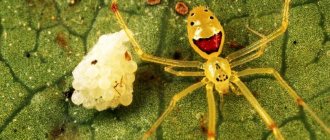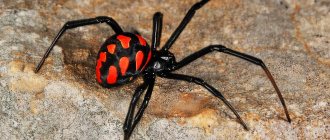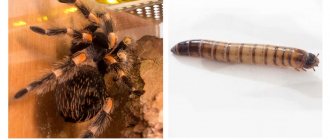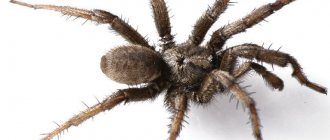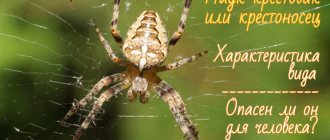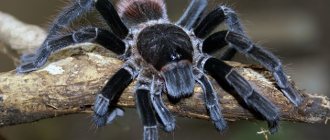South Russian tarantula
Relatively recently (since 2008) a new species of spider appeared in Belarus - the South Russian tarantula.
According to experts, the number of these spiders in our country is increasing due to abnormal heat and climate change. Most often, the tarantula can be found in the Gomel region on the grassy open banks of Pripyat and Sozh.
Spiders grow on average to 25-30 millimeters. The body is densely covered with hair. The tarantula is brownish-red on top and black underneath. They live in burrows lined with cobwebs.
During the day, tarantulas sit in burrows; at night they are more active and can leave the shelter a short distance. Spiders can climb into residential buildings, especially in small towns.
The tarantula avoids humans, but it is poisonous and can bite. Most often, spiders bite people who step on them through carelessness. A tarantula spider's bite is comparable to a hornet's bite and is not fatal, but is very painful and can cause severe inflammation.
Photo: ru.wikipedia.org
Tarantulas have chosen a Belarusian village in the Gomel region
People kill them for fear of being bitten.
A subscriber of the “Ranak” group on VK sent photos of tarantulas with the caption: “Agricultural town of Dubrova: tarantulas have chosen the livestock complex.”
Alexander said that spiders are periodically spotted on the farm. “I personally saw several over the past week. We saw them last year, but not many. This year there are many more of them. I found out on the Internet that this is a South Russian tarantula. I compared the photos."
Alexander did not hear about whether cases of bites were recorded in the agricultural town. “But some are afraid to even work, so they kill spiders out of fear. I caught another one today. Alive."
Agro-town Dubrova (Svetlogorsk district): tarantulas have chosen a livestock complex
Let us remember that “Ranak” spoke about the “Svetlogorsk” tarantulas a couple of years ago. A summer resident from the village of Shupeiki discovered them on his property. “When I was mowing, I saw something big, like a mouse, running in the grass,” Andrey said. – This time I saw minks first, and then them. The first spider was 7-8 centimeters. And he doesn’t run away, but rears up and raises his paws...”
Vladislav Ivanov, junior researcher at the laboratory of terrestrial invertebrate animals of the National Academy of Sciences of Belarus for Bioresources, describes Belarusian tarantulas as follows: “Females can reach five centimeters, males are half that size. This is the size of the body, excluding the legs. Visually, it can reach eight centimeters. Like all spiders, it feeds on invertebrate animals mainly – insects.”
“Spiders live in deep burrows, 30-40 centimeters long. He is very shy, he hides himself if you see him,” the deputy dean of the Faculty of Biology of Gomel State University told reporters. F. Skaryna Nikolai Galinovsky. “His bite is like a hornet’s bite.”
A tarantula spider bite is not fatal to humans, but an allergic reaction, including anaphylactic shock, can occur. Swelling or swelling may occur at the site of the bite. Typically, victims of this spider's bite do not require any special treatment unless an allergic reaction occurs. First aid for a tarantula bite should be provided immediately: the wound must be washed, applied cold and, if possible, taken an antihistamine.
According to information from the Svetlogorsk Zonal Center for Hygiene and Epidemiology, no complaints from residents of the city and region about tarantula bites have been recorded.
Due to climate warming, in addition to tarantula spiders, other heat-loving insects began to appear in Belarus, in particular, mantises and locusts. As we have already said, Svetlogorsk residents are increasingly seeing the latter at their dachas. In some cases, like with our colleague, the locusts simply flew onto the balcony.
Hornets
The common hornet, or hornet wasp, is the largest wasp living in Belarus. The body size of an adult is 3 cm or more. Often the habitat of these insects are wooden buildings of people, tree hollows, and beehives. Hornets feed on plant nectar and small insects, such as bees.
The hornet is a rather bright insect: its head and abdomen are yellow or yellow-red with black spots, and its chest is dark. Hornets' wings are small, thin and transparent.
Hornet nests are similar to wasp nests and have a similar structure, only they are usually brown rather than gray.
Hornets are relatively non-aggressive. As a rule, they attack and bite only when it comes to protecting themselves and their own home. Hornets sting painfully because a lot of poison gets into the wound - up to 2 mg (2.5 times more than with a bee sting).
The bite of one hornet in an adult can cause swelling, fainting and general suffocation with a severe allergic reaction. It is much worse if a whole family of these insects attacks. A person can die from a large amount of poison.
Photo: ru.wikipedia.org
TOP 5 dangerous insects and spiders in Belarus
In our country there are not many insects that pose a danger to humans, but you need to know about them. Bees, hornets, mosquitoes, midges, and ticks can ruin not only your vacation. The consequences can be much more serious. Intex-press has prepared a selection of insects that pose a real danger to humans.
South Russian tarantula
Relatively recently (since 2008) a new species of spider appeared in Belarus - the South Russian tarantula. According to experts, the number of these spiders in our country is increasing due to abnormal heat and climate change.
Most often, the tarantula can be found in the Gomel region on the grassy open banks of Pripyat and Sozh.
Spiders grow on average to 25-30 millimeters. The body is densely covered with hair. The tarantula is brownish-red on top and black underneath. They live in burrows lined with cobwebs.
During the day, tarantulas sit in burrows; at night they are more active and can leave the shelter a short distance. Spiders can climb into residential buildings, especially in small towns.
The tarantula avoids humans, but it is poisonous and can bite. Most often, spiders bite people who step on them through carelessness. A tarantula spider's bite is comparable to a hornet's bite and is not fatal, but is very painful and can cause severe inflammation.
Hornets
The common hornet, or hornet wasp, is the largest wasp living in Belarus. The body size of an adult is 3 cm or more. Often the habitat of these insects are wooden buildings of people, tree hollows, and beehives. Hornets feed on plant nectar and small insects, such as bees.
The hornet is a rather bright insect: its head and abdomen are yellow or yellow-red with black spots, and its chest is dark. Hornets' wings are small, thin and transparent.
Hornet nests are similar to wasp nests and have a similar structure, only they are usually brown rather than gray.
Hornets are relatively non-aggressive. As a rule, they attack and bite only when it comes to protecting themselves and their own home. Hornets sting painfully because a lot of poison gets into the wound - up to 2 mg (2.5 times more than with a bee sting).
The bite of one hornet in an adult can cause swelling, fainting and general suffocation with a severe allergic reaction. It is much worse if a whole family of these insects attacks. A person can die from a large amount of poison.
German wasps
German wasps, or mutilids, or velvet ants, are furry wasps from the order Hymenoptera. They reach from 5 to 30 millimeters in length. Males and females have completely different body shapes. As a rule, males are larger than females and have wings. Males are black or brown, often with rusty-red breast sclerites, while females are brighter colored, usually with rusty-red breasts.
German wasps do not build their own nests, but prefer to live in others. There they lay their eggs in the larvae of the owner of this nest, which then become food for the wasp larva. Its pupation also occurs here.
For humans, the pricks of these furry wasps are quite painful. The pain goes away only after a few hours.
Ticks
The tick is one of the oldest inhabitants inhabiting our planet. Contrary to erroneous belief, ticks are not insects, but are representatives of the arachnid order.
These representatives of arthropods rarely reach 3 mm in size; the size of mites generally ranges from 0.1 to 0.5 mm.
Blood-sucking predatory ticks wait for their prey, lying in ambush on the grass and branches. With the help of paws equipped with claws and suction cups, they cling to the body, fur or clothing, and then move around in search of delicate skin. When choosing a bite site, they can crawl from 10 minutes to two hours.
A tick bite can be very dangerous, since ticks are carriers of diseases, including encephalitis. Ticks can survive without food for up to 3 years, but once they find a victim, they voraciously begin to feed on blood and can increase their weight by 120 times.
Let us remind you that in the 6th month of 2021, 16 residents of the Baranovichi region became infected with Lyme borreliosis from tick bites.
intex-press.by
German wasps
German wasps, or mutilids, or velvet ants, are fluffy wasps from the order Hymenoptera. They reach from 5 to 30 millimeters in length. Males and females have completely different body shapes. As a rule, males are larger than females and have wings. Males are black or brown, often with rusty-red breast sclerites, while females are brighter colored, usually with rusty-red breasts.
German wasps do not build their own nests, but prefer to live in others. There they lay their eggs in the larvae of the owner of this nest, which then become food for the wasp larva. Its pupation also occurs here.
For humans, the pricks of these furry wasps are quite painful. The pain goes away only after a few hours.
Photo: ru.wikipedia.org
Ticks
The tick is one of the oldest inhabitants inhabiting our planet. Contrary to the erroneous belief, ticks are not insects, but are representatives of the arachnid order, according to the website nashzeleniymir.ru.
These representatives of arthropods rarely reach 3 mm in size; the size of mites generally ranges from 0.1 to 0.5 mm.
Photo: sudexpert.gov.by
Blood-sucking predatory ticks wait for their prey, lying in ambush on the grass and branches. With the help of paws equipped with claws and suction cups, they cling to the body, fur or clothing, and then move around in search of delicate skin. When choosing a bite site, they can crawl from 10 minutes to two hours.
A tick bite can be very dangerous, since ticks are carriers of diseases, including encephalitis. Ticks can survive without food for up to 3 years, but once they find a victim, they voraciously begin to feed on blood and can increase their weight by 120 times.
Let us remind you that in the 6th month of 2021, 16 residents of the Baranovichi region became infected with Lyme borreliosis from tick bites.
BrestCITY. News
Large spiders attacked the Gomel region. This time the insects encircled the village of Udarnoye, Lelchitsy district.
Residents meet them in their gardens, barns, and today one of these uninvited guests even snuck into the house!
Akin to a horror movie script. But seriously, eyewitnesses describe the tarantulas themselves as aggressive insects that are not afraid to attack. Maxim Vecherkov went on a dangerous business trip.
It was a fight, Nadezhda says. Seeing a huge shaggy spider approaching the baby's crib, she took the firecracker. But the guest did not even think about hiding - he began to jump sharply towards him.
The woman sounded the alarm. And you didn’t even have to show proof at the bank - just a day later the same spider made its way into the local school. Teachers immediately noticed the size and unusual color.
Situations began to repeat themselves as if they were carbon copies. Spiders were seen at a local medical center, then in a store, and at a construction site. In the village the only talk is about the insect invasion. And this is the second part of the story about tarantulas.
This is 150 kilometers from Udarny. According to experts, the spiders may have been accidentally transported with cargo.
Scientists confirm that this is a real South Russian tarantula. Can reach the size of a human palm. The species itself, although rare, is still found in our southeast. And due to climate warming, their habitat is expanding and their activity is increasing.
The tarantulas most likely come from the forest. It's literally 200 meters away. Although, by their nature, due to sensitivity to any vibrations, they should be very timid: sit in burrows and lead a hidden lifestyle. But, apparently, something went wrong - these, on the contrary, are too brave.
Scientists do not know what brought them to the village and why spiders approach humans. But such behavior, they say, is truly unnatural. They urge you not to panic and stay on the defensive.
Nikolai Galinovsky, entomologist, candidate of biological sciences: “One of the methods is treatment with repellent agents or ultrasound, as is the case for cockroaches using an ultrasound device in a socket, you can try for spiders.”
And if the situation suddenly gets out of control, the regional center will have to be involved. The village authorities say that the problem cannot be solved on their own.
Mikhail Bovsunovsky, Chairman of the Udarnensky Rural Executive Committee: “Of course, we will attract those specialists who are necessary, if these are really spiders, and even dangerous, poisonous ones, of course, measures will be taken - this is not a joke.”
Spiders are poisonous. But with a caveat. The impact on humans can be compared to the bite of a hornet. It is not fatal, but in some cases, however, a severe allergic reaction may occur. In general, there are more than ten species of large spiders that can bite through human skin in Belarus. And not all of them are harmless.
Now in Udarny, volunteers are combing the surrounding area in small groups. They are looking for nests that have begun to appear in residential areas, near the first floors of apartment buildings. For now, spiders are simply caught with bait and locked in a jar to be shown to scientists later.
Source of information: ONT.
09.22.2018.
News on the topic: animals Views: Subscribe to Brest News in Google Read BrestCITY in Yandex.News ———————-
